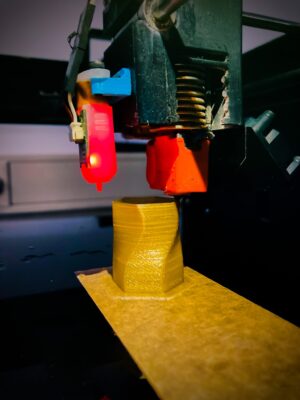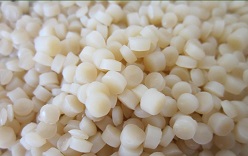Paques Biomaterials, producer of PHAs (polyhydroxyalkanoates), has obtained a subsidy of € 14 million in order to commercialize its technology. The development of this material called Caleyda® will take place in Emmen, the Netherlands. PHAs are attractive biologically downgradable plastics – but why does their development take so long? This activity spans much more than 10 years; and now again a sizeable amount of subsidy is required to take this development a few steps further down the road.

Major promises
In earlier articles on this site, we often discussed PHA’s advantages and its potential. PHAs are sustainable materials, because they can be broken down to harmless components. They release no microplastics or harmful nanoparticles and will not pollute any further the oceans and waterways. They can be made from organic waste streams, even from sewage. They will not incur cost. Although we should ask: how constant will the composition of such streams are, and how many m3 should we process in order to arrive at one ton of end product? No doubt, this will be much more than in the case of all fossil alternatives; also more than with existing bioplastics like Corbion’s PLA and Avantium’s PEF. Nevertheless, market expectations are high and the Netherlands play an important part in the international field.
Problems may be bigger than expected
For several decades now, marketing new materials appears to be a matter of endurance. Markets are being served well, by a whole range of products. And as long as the mere size of energy markets can serve fossil-based materials, a niche product will have a difficult time to arrive at more than a niche market. PHAs may look forward to such a future.
For there is more at stake. All aspects of the processes that produce PHAs come with challenges of their own. We already mentioned the sheer number of resources to be processed. What will we do with the side streams resulting from this? Will they incur any costs? How vulnerable will the microorganisms producing the PHA be for changes in the makeup of the resource? For these are waste streams, and often these will not come with any guarantees on their quality. But the main obstacle will lie in the limited experience with the process technology employed; and in the downstream process.
Unknown process technologies
For all polymer materials, the start of the process almost always consists of a massive and concentrated supply of the monomer, resulting in a maximum output/l/hr. Mostly, atom economics and process productivity are very high. All fossil polymers, including the bioplastics PLA and PEF, conform to this principle.
In the case of PHAs, we start with very diluted solutions. Therefore, the PHA process technology bears resemblance to a fermentation process, in which a microorganism extracts its nutrients from the medium, stays alive and produces an intended end product as a result. From an industrial point of view, we have much experience with fermentation processes. But very rarely do we produce polymers in this way. Most fermentation processes are about the production of monomers, certainly in the case of major commodities. The extraction and possible purification are common processes. But in the case of PHAs, product separation will have to be invented; and we also need to deal with the question how the system will reproduce earlier results. Particularly, the degree of polymerization may vary, what will bear its effect on the recoverability of the PHA in question, and all applications that go with it.

Downstream processes are the real bottleneck
Much has been published about extraction of PHAs from the cell mass. Characteristic of the problems encountered. The body of the cell needs to be broken down in order to set free the PHAs. We can arrive there using oxidation agents like hypochlorite or bleach: agents that may damage PHA’s quality. The waste stream that this procedure will generate, needs to be processed and discarded, with costs involved. As an alternative, or in combination with this, we could employ organic solvents in order to extrude the PHAs from the cell mass. Even halogenated hydrocarbons are being mentioned as good solvents.
This is an important departure from the well-developed polymer process technology. In this case, we need to use diluted process streams from which to separate the product; and then, we will have to regenerate the solvent as well. This represents quite a number of process steps; and each step could possibly change the polymer’s quality. Reproducibility is critical in working with polymer materials, and that might be a major problem here. And then, it may also affect scale increase.
Expensive or sustainable?
All this will explain why the breakthrough of PHAs takes so long. We may doubt if this will ever come about. Process costs will be particularly high in actual production. Because of them, PHAs will be more expensive than most classical materials, or the bioplastics PEF and PLA mentioned earlier. All this points towards niche application; which will stand in the way of a high market potential.
And to what extent can we label PHAs as sustainable materials? Discussion on that matter will not die down. In view of the large number of process steps, some LCA analyses predict that PHA’s footprint will be higher than that of the major fossil polymers. On the other hand, PHA resource costs will be low – and upon further optimization, much can be improved. The latter insight stems from experiences in fine chemistry. But then, in the case of PHA a small change in process conditions might have an impact on the end product’s quality.
Problems, problems
As yet, the road hasn’t been cleared for general application of PHAs yet. Isolation of the substance from the cell’s cytoplasm is quite difficult. Chemically complicated and not cost effective, so far. There is a lot of research going on, reviewing different techniques. Often, organic solvents are being used – not very attractive for industrial deployment. In medical applications for instance, the PHA should be perfectly free of solvents. On the other hand, if the object is production of plastic bags, such solvents are much less of a problem. Moreover, many process steps break up long chains, not favourable for plastic applications. And above all: often the cost of such extractions are high – which also stands in the way of actual applications.
Therefore, researchers look for new approaches. In one such approach for instance, they used solvents in order to isolate PHAs from Ralstonia eutropha and Escherichia coli. In another investigation, researchers used mealworms (larvae of the mealworm beetle, Tenebrio molitor). These secrete the PHA in almost pure form in their excrements. Innovative methods, but not quite useful in mass production.
How to proceed?
As yet, here is no light at the end of the tunnel. Activities around fossil plastics surge. Installations for recycling of the classical plastics are many times bigger than present and planned PLA capacity. Yes, it’s true: entrepreneurs in the reuse business go through difficult times – because low oil prices favour the use of virgin materials. But the infrastructure for keeping plastics out of the environment is being built up; in total, quite an advance on market introduction of PHAs.
Interesting? Then also read:
Market introduction of PHAs
PHAs on the rise: for the first time, demand outstrips supply
PHA: promising, versatile, biodegradable
